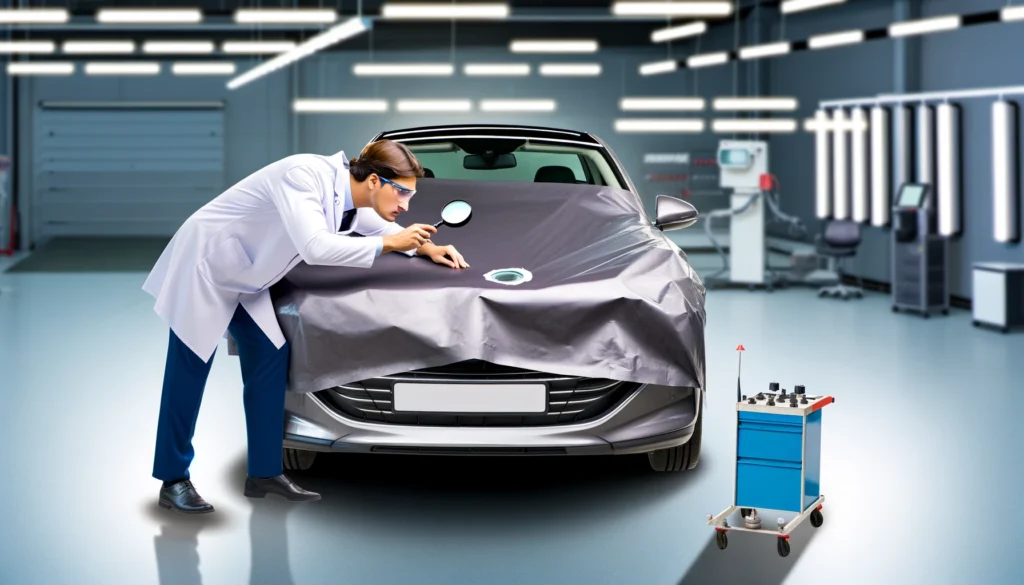- February 6, 2024
- By 60 Minute Website Challenge
- In windscreen replacement, windscreens-tinting, windshield repair near me
- Tags glass repair, Service Areas, Windscreen repair near Earlwood
- 14
- 0

Picture this: you’re cruising down the open road, the wind in your hair, and the sun shining down on your face. The world is your oyster, and nothing can dampen your spirits. But suddenly, you hear a loud crack. Your heart sinks as you realize what has just happened – a rock has chipped your windshield. Now you’re faced with a dilemma: do you ignore it and risk further damage, or do you take action and get it fixed? If you choose the latter, you’ll need to know how to choose the right materials for a durable windshield resealing. When it comes to selecting the materials for a windshield resealing, it’s not as simple as grabbing any adhesive off the shelf. You need something that will provide a lasting fix, ensuring that your windshield remains secure and protected against the elements. In this blog post, we will delve into the world of windshield resealing and explore the key factors to consider when choosing the right materials for a durable fix. But before we dive in, let’s address the elephant in the room – why is a durable windshield resealing so important in the first place? Well, aside from obvious reasons like preserving the structural integrity of your vehicle, a secure windshield plays a crucial role in your safety on the road. A properly sealed windshield is better equipped to withstand impact and can prevent shattering upon collision, reducing the risk of injury. So, if you want to ensure your peace of mind and protect yourself and your passengers, it’s time to learn the ins and outs of choosing the right materials for a durable windshield resealing. Buckle up, because we’re about to seal the deal!

Before we delve into the nitty-gritty of choosing the right materials for a durable windshield resealing, let’s first understand why it is so important. Your windshield is not just a piece of glass that keeps the wind and rain out of your car; it plays a crucial role in maintaining the structural integrity of your vehicle and ensuring your safety on the road.
A properly sealed windshield acts as a barrier against external forces, such as rocks, debris, and even collisions. It helps to distribute the impact evenly across its surface, reducing the risk of shattering and minimizing the chances of injury to you and your passengers. In addition to protecting you from physical harm, a secure windshield also enhances your driving experience by reducing noise and providing better visibility.
Now that we understand why a durable windshield resealing is essential let’s move on to evaluating the different types of windshield adhesives available in the market.

When it comes to choosing an adhesive for your windshield resealing, you’ll come across various options in the market. Each type has its own set of characteristics and benefits. Let’s take a closer look at some common types:
1. Polyurethane Adhesive: This type of adhesive is widely used in automotive applications due to its excellent bonding strength and flexibility. It provides a strong seal that can withstand vibrations and temperature changes, making it ideal for long-lasting results.
2. Silicone Adhesive: Silicone adhesives offer high resistance to extreme temperatures and weather conditions. They are known for their durability and ability to maintain flexibility over time. However, they may not provide as strong of a bond as polyurethane adhesives.
3. Butyl Adhesive: Butyl adhesives are commonly used for windshield installations due to their excellent sealing properties. They have good adhesion to both glass and metal surfaces, providing a reliable seal against water and air infiltration.
4. Acrylic Adhesive: Acrylic adhesives are known for their fast curing time and high initial bond strength. They offer good resistance to weathering and UV radiation, making them suitable for outdoor applications.
Now that we have evaluated the different types of windshield adhesives, let’s move on to the next step – considering the factors that should be taken into account when choosing the right adhesive materials.

Choosing the right adhesive materials for your windshield resealing is crucial to ensure a durable fix. Here are some key factors you should consider:
1. Compatibility: It is essential to choose an adhesive that is compatible with your windshield material. Different types of glass require different adhesives for optimal bonding.
2. Application Method: Consider the application method required for the adhesive you choose. Some adhesives may require special equipment or professional installation, while others can be applied easily by following simple instructions.
3. Curing Time: The curing time of the adhesive is another important factor to consider. Some adhesives may require longer curing times, which can affect the overall timeline of your resealing project.
4. Environmental Factors: Take into account the weather conditions in your area and choose an adhesive that can withstand extreme temperatures, humidity, and UV radiation.
By considering these factors, you can ensure that you select an adhesive material that meets your specific requirements and provides a durable fix for your windshield resealing.
As mentioned earlier, it is crucial to choose an adhesive that is compatible with your windshield material. Different types of glass require different adhesives for optimal bonding. Here are some common types of windshields and the corresponding adhesives:
1. Laminated Glass: Most modern vehicles come equipped with laminated glass windshields, which consist of two layers of glass with a layer of polyvinyl butyral (PVB) sandwiched in between. For laminated glass windshields, polyurethane adhesive is the recommended choice due to its excellent bonding strength and compatibility with PVB.
2. Tempered Glass: Some older vehicles may have tempered glass windshields, which are made by heating and cooling the glass rapidly to increase its strength. For tempered glass windshields, silicone adhesive or butyl adhesive can be used for resealing.
It is important to consult your vehicle manufacturer’s guidelines or seek professional advice to determine the compatibility of adhesives with your specific windshield material.
The temperature and weather conditions in your area play a significant role in determining the right adhesive material for your windshield resealing. Extreme temperatures can affect the performance and durability of certain adhesives.
If you live in an area with hot summers or cold winters, it is essential to choose an adhesive that can withstand these temperature extremes without compromising its sealing properties. Polyurethane adhesives are known for their excellent resistance to temperature variations and are often recommended for regions with extreme weather conditions.
In addition to temperature, consider other environmental factors such as humidity and UV radiation. Exposure to high levels of UV radiation can cause adhesives to degrade over time, leading to reduced bonding strength and potential leaks. To ensure long-lasting results, opt for an adhesive that offers UV resistance.
UV-resistant adhesives offer several benefits when it comes to windshield resealing. Here are some key advantages:
1. Enhanced Durability: UV-resistant adhesives are formulated to withstand prolonged exposure to sunlight without degrading or losing their bonding strength. This ensures a durable fix that can withstand the test of time.
2. Reduced Risk of Leaks: Adhesives that are not UV-resistant may deteriorate over time when exposed to UV radiation, leading to potential leaks and water infiltration. By choosing a UV-resistant adhesive, you can minimize the risk of leaks and maintain a watertight seal.
3. Protection Against Fading: Sunlight can cause fading and discoloration of materials over time. UV-resistant adhesives help protect your windshield from fading, ensuring that it remains clear and aesthetically pleasing.
When selecting an adhesive for your windshield resealing, consider opting for a UV-resistant formula to enjoy these added benefits.
Proper preparation of the windshield surface is crucial for achieving a successful resealing. Here are some tips to ensure you get it right:
1. Clean the Surface: Thoroughly clean the windshield surface using a mild detergent or glass cleaner to remove any dirt, debris, or old adhesive residue. Ensure that the surface is completely dry before proceeding with the resealing process.
2. Remove Old Adhesive: If there is any old adhesive remaining on the windshield, use a razor blade or adhesive remover to carefully scrape it off. Be gentle to avoid scratching the glass.
3. Use Primer if Required: Some adhesives may require the use of a primer for optimal bonding. Follow the manufacturer’s instructions and apply the primer to the designated areas of the windshield surface.
By following these tips, you can ensure that your windshield surface is properly prepared for resealing, allowing for better adhesion and a more durable fix.
Now that you have chosen the right adhesive and prepared your windshield surface, it’s time to apply the adhesive. Here is a step-by-step guide:
1. Apply Adhesive: Follow the manufacturer’s instructions and apply the adhesive in a continuous bead along the perimeter of the windshield frame or bonding area. Ensure that you achieve full coverage without any gaps or voids.
2. Install Windshield: Carefully place the windshield onto the adhesive, aligning it with the frame or bonding area. Apply gentle pressure to ensure proper contact between the glass and adhesive.
3. Secure Windshield: Use suction cups or tape to hold the windshield in place while allowing sufficient time for curing as per manufacturer recommendations.
4. Clean Excess Adhesive: Once the adhesive has cured, remove any excess material using a razor blade or appropriate tool. Be cautious not to damage or scratch your newly installed windshield.
The curing time of your chosen adhesive is crucial for achieving optimal results. It is essential to follow manufacturer recommendations regarding curing time before subjecting your vehicle to stress or extreme weather conditions.
Avoid washing your vehicle or exposing it to rain for at least 24 hours after the resealing process to allow the adhesive to fully cure. This will ensure a strong and durable bond between the windshield and the frame.
Additionally, be mindful of any specific post-application care instructions provided by the adhesive manufacturer. Following these guidelines will help maintain the integrity of the adhesive and ensure long-lasting results.
Choosing the right materials for a durable windshield resealing is crucial for your safety on the road and preserving the structural integrity of your vehicle. By understanding the importance of a secure windshield, evaluating different types of adhesives, considering compatibility with your windshield, assessing environmental factors, exploring UV-resistant options, properly preparing the surface, following a step-by-step application guide, and allowing sufficient curing time, you can achieve optimal results.
Remember to consult your vehicle manufacturer’s guidelines or seek professional advice when in doubt. A properly sealed and durable windshield will not only provide peace of mind but also enhance your driving experience. So don’t compromise on safety – seal the deal with confidence!
Book your appointment now and get 10% discount.
And give us google 5 Stars feedback and get a free drink on us.
MAKE APPOINTMENT



